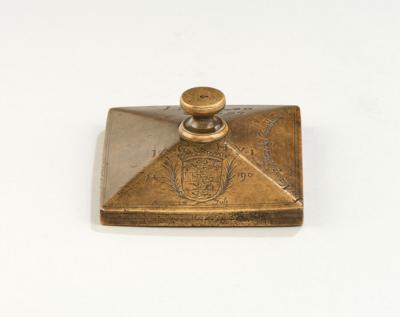A weight of 1 pound and 20 lots, Styria 1690

from the estate of Abondio von Inzaghi (1617-1691), brass, rectangular, pyramid-shaped, the mid-section with round handle, calibrated with the Styrian panther (calibration mark panther with calibration master initials AH), engraved with the year 1690, the owner’s coat of arms and initials IACVHVI (John Anthony Count and Lord of Inzaghi), the date 12 July 1690 and the motto "IesuNazareniZelotemAg oGloriamHuiIntendo" (I confirm myself as a follower of Jesus from Nazareth, to increase his fame). Size c. 86 x 86 mm, weight 909 g. (= c. 1 pound + 20 lots = 52 lots). Abondio or Johann Anton von Inzaghi was born in Como (Duchy of Milan). His father was probably a money trader. in 1644, A. I. is explicitly mentioned for the first time in Styria as a money changer. Through marriage he gained access to the imperial house (Emperor Leopold I) in Vienna. In addition to money trading, in 1648 he also engaged in exporting mercury from Idria in Istria and trading in copper, livestock and textiles. In 1655 he was appointed Münzmeister (“mint master”), and in 1656 he was dismissed from his office because of irregularities. However, in the same year he was appointed Court Chamber Councillor. Thanks to his commercial skills, especially in the export of mercury, he secured important sources of income for the Emperor. In 1663, he was raised to the rank of baron (“Freiherr”), and in 1686 to the rank of count (“Graf”). At the time of his death in 1691, he left his heirs a considerable fortune. According to Günter Unselm, the unit “52 lot” could be linked to the mercury trade. It could also, however, be connected to the production of mercury. The weight unit 52 lot is mentioned, for example, in “Putrefaction zu Mercurius Philosophorum” (in: Alchymistische Practic, Andreas Libavius, Frankfurt 1603, p. 267.) 52 lot cement powder is also used in the cementation of gold, namely the "cementation of 32 ducats" (in: ... Curieuse Kunst- und Weck-Schul, Nuremberg 1705.).
Published:
Günter Unselm, rätselhaftes Gewicht, in: Maß und Gewicht, no. 3 October 2003, Annual Volume 2002.
Provenance:
Antique trade, Cologne, Private Collection Günter Unselm, Collection of Dr. Gerhard Eiselmayr No. 983a.
Esperto: Simon Weber-Unger
 Simon Weber-Unger
Simon Weber-Unger
+43-1-515 60-269
simon.weber@dorotheum.at
29.09.2022 - 12:45
- Prezzo realizzato: **
-
EUR 6.400,-
- Prezzo di partenza:
-
EUR 2.000,-
A weight of 1 pound and 20 lots, Styria 1690
from the estate of Abondio von Inzaghi (1617-1691), brass, rectangular, pyramid-shaped, the mid-section with round handle, calibrated with the Styrian panther (calibration mark panther with calibration master initials AH), engraved with the year 1690, the owner’s coat of arms and initials IACVHVI (John Anthony Count and Lord of Inzaghi), the date 12 July 1690 and the motto "IesuNazareniZelotemAg oGloriamHuiIntendo" (I confirm myself as a follower of Jesus from Nazareth, to increase his fame). Size c. 86 x 86 mm, weight 909 g. (= c. 1 pound + 20 lots = 52 lots). Abondio or Johann Anton von Inzaghi was born in Como (Duchy of Milan). His father was probably a money trader. in 1644, A. I. is explicitly mentioned for the first time in Styria as a money changer. Through marriage he gained access to the imperial house (Emperor Leopold I) in Vienna. In addition to money trading, in 1648 he also engaged in exporting mercury from Idria in Istria and trading in copper, livestock and textiles. In 1655 he was appointed Münzmeister (“mint master”), and in 1656 he was dismissed from his office because of irregularities. However, in the same year he was appointed Court Chamber Councillor. Thanks to his commercial skills, especially in the export of mercury, he secured important sources of income for the Emperor. In 1663, he was raised to the rank of baron (“Freiherr”), and in 1686 to the rank of count (“Graf”). At the time of his death in 1691, he left his heirs a considerable fortune. According to Günter Unselm, the unit “52 lot” could be linked to the mercury trade. It could also, however, be connected to the production of mercury. The weight unit 52 lot is mentioned, for example, in “Putrefaction zu Mercurius Philosophorum” (in: Alchymistische Practic, Andreas Libavius, Frankfurt 1603, p. 267.) 52 lot cement powder is also used in the cementation of gold, namely the "cementation of 32 ducats" (in: ... Curieuse Kunst- und Weck-Schul, Nuremberg 1705.).
Published:
Günter Unselm, rätselhaftes Gewicht, in: Maß und Gewicht, no. 3 October 2003, Annual Volume 2002.
Provenance:
Antique trade, Cologne, Private Collection Günter Unselm, Collection of Dr. Gerhard Eiselmayr No. 983a.
Esperto: Simon Weber-Unger
 Simon Weber-Unger
Simon Weber-Unger
+43-1-515 60-269
simon.weber@dorotheum.at
|
Hotline dell'acquirente
lun-ven: 10.00 - 17.00
kundendienst@dorotheum.at +43 1 515 60 200 |
| Asta: | La collezione di bilance e pesi del Dr. Eiselmayr |
| Tipo d'asta: | Asta online |
| Data: | 29.09.2022 - 12:45 |
| Luogo dell'asta: | Wien | Palais Dorotheum |
| Esposizione: | Online |
** Prezzo d’acquisto comprensivo dei diritti d’asta acquirente e IVA
Non è più possibile effettuare un ordine di acquisto su Internet. L'asta è in preparazione o è già stata eseguita.
